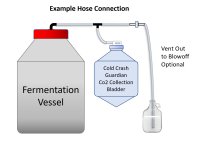Nicasio Tom
Brewer
- Joined
- Mar 27, 2015
- Messages
- 34
- Reaction score
- 0
For my single-stage fermentation in a temp-controlled refrigerator, I ran a blow-off tube from the carboy into a container of Star-San solution. The tube worked great during a vigorous fermentation. I kept the blow-off tube in place, and after fermentation stopped, I dry-hopped for a few days and then cold-crashed to 38º. Stupidly, I didn't think it would, but the pressure differential sucked about a half-gallon of the sanitizer solution into the carboy. Not good. I dumped the batch. What should I do next time? Use foil? How serious is the risk of O2 in late fermentation? – Nicasio Tom

